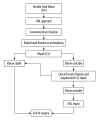Does Timing of Surgery Affect Treatment of the Terrible Triad of the Elbow?
- PMID: 29985910
- PMCID: PMC6069562
- DOI: 10.12659/MSM.907146
Does Timing of Surgery Affect Treatment of the Terrible Triad of the Elbow?
Abstract
BACKGROUND This study investigated the influence of surgical timing on the treatment of terrible triad of the elbow (TTE). MATERIAL AND METHODS After exclusion, 63 patients were enrolled in this study: 20 patients were classified into the emergency group (group A, within 24 h after injury), 26 into the early surgery group (group B, from 4 to 14 days after injury), and 17 into the delayed surgery group (group C, more than 14 days after injury). All patients underwent the same approach, and elbow motion and complication rates were recorded and compared. RESULTS Fifty-eight patients were followed up (mean 20.5±1.9 months), and 5 patients had lost partial final data. At 1 month after the operation, elbow motion in group A was higher than in group B and group C (P<0.01); however, 3 or more months later, there was no distinct difference between group A and group B (P>0.05), while both group A and group B showed better outcomes than group C at all time points (P<0.05). Moreover, group A and group B had better higher elbow motion, MEPS, excellent and good rate than group C at the final clinical visit (all P<0.05). No postoperative pain or complication rate differences were found among the 3 groups except for elbow stiffness (2 in group A, 3 in group B, and 7 in group C) (P<0.05) which required reoperation to enhance elbow function. CONCLUSIONS Emergency or early operation for TTE patients were more effective than delayed operation.
Figures


References
-
- Hotchkiss R. Rockwood & Greens Fractures in Adults. 1996. Fracture and dislocation of the elbow.
-
- Ring D, Jupiter JB, Zilberfarb J. Posterior dislocation of the elbow with fractures of the radial head and coronoid. J Bone Joint Surg Am. 2002;84A:547–51. - PubMed
-
- McKee MD, Pugh D, Wild E, et al. Standard surgical protocol to treat elbow dislocations with radial head and coronoid fractures. Surgical technique. J Bone Joint Surg Am. 2005;87:22–32. - PubMed
-
- Schneeberger AG, Sadowski MM, Jacob HA. Coronoid process and radial head as posterolateral rotatory stabilizers of the elbow. J Bone Joint Surg Am. 2004;86A:975–82. - PubMed
-
- Martin R, Mazzini J, Lopez D, et al. Medial complex elbow dislocation: An unusual pattern of injury. J Orthop Trauma. 2010;24:e21–24. - PubMed
MeSH terms
LinkOut - more resources
Full Text Sources
Other Literature Sources

